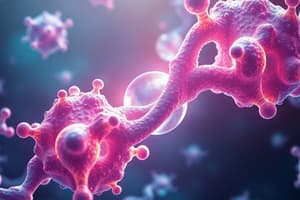Podcast
Questions and Answers
What is the primary role of enzymes in biological reactions?
What is the primary role of enzymes in biological reactions?
- To speed up chemical reactions by lowering activation energy (correct)
- To synthesize substrates for chemical reactions
- To provide energy for chemical reactions
- To catalyze all chemical reactions regardless of conditions
What structural component primarily composes enzymes?
What structural component primarily composes enzymes?
- Lipids
- Carbohydrates
- Nucleic acids
- Proteins or RNA (correct)
Which of the following best describes the enzyme-substrate complex formation?
Which of the following best describes the enzyme-substrate complex formation?
- The substrate binds to the enzyme's active site (correct)
- The substrate inhibits the active site
- The enzyme and substrate combine to form a larger substrate
- The enzyme denatures before substrate binding
How does temperature affect enzyme activity?
How does temperature affect enzyme activity?
What distinguishes competitive inhibitors from non-competitive inhibitors?
What distinguishes competitive inhibitors from non-competitive inhibitors?
Which of the following best describes coenzymes?
Which of the following best describes coenzymes?
What happens when substrate concentration increases beyond a certain point?
What happens when substrate concentration increases beyond a certain point?
Why are enzymes important for living organisms?
Why are enzymes important for living organisms?
Flashcards are hidden until you start studying
Study Notes
Enzymes in Biology
Definition
- Enzymes are biological catalysts that speed up chemical reactions in living organisms.
- They lower the activation energy required for reactions.
Structure
- Made of proteins (mostly) or RNA (ribozymes).
- Composed of one or more polypeptide chains folded into a specific three-dimensional shape.
Function
- Catalyze metabolic reactions, including digestion, energy production, and biosynthesis.
- Specificity: Each enzyme acts on a specific substrate due to its unique active site.
Mechanism of Action
- Substrate Binding: The substrate binds to the enzyme's active site, forming an enzyme-substrate complex.
- Transition State: The enzyme stabilizes the transition state, lowering activation energy.
- Product Formation: The substrate is transformed into product(s) and released from the active site.
- Enzyme Recovery: The enzyme is free to catalyze another reaction.
Factors Affecting Enzyme Activity
- Temperature: Each enzyme has an optimal temperature. Excessive heat can denature enzymes.
- pH: Enzymes also have an optimal pH. Deviations can reduce activity or denature the enzyme.
- Substrate Concentration: Increasing substrate can increase reaction rate until saturation occurs.
- Inhibitors: Molecules that decrease enzyme activity. Types include:
- Competitive Inhibitors: Compete with substrates for the active site.
- Non-competitive Inhibitors: Bind to an enzyme at a site other than the active site, altering its function.
Cofactors and Coenzymes
- Cofactors: Inorganic ions (e.g., Mg²⁺, Zn²⁺) that assist enzyme function.
- Coenzymes: Organic molecules (e.g., vitamins) that play a crucial role in enzyme activity.
Importance of Enzymes
- Essential for metabolic processes and energy production.
- Regulation of biochemical pathways.
- Involved in DNA replication and repair.
- Applications in biotechnology, medicine, and industry (e.g., fermentation, diagnostics).
Enzyme Kinetics
- Study of the rates of enzyme-catalyzed reactions.
- Often modeled using the Michaelis-Menten equation, which describes the relationship between substrate concentration and reaction rate.
Regulation of Enzyme Activity
- Allosteric Regulation: Enzymes have allosteric sites where molecules can bind and change enzyme activity.
- Feedback Inhibition: End products of a metabolic pathway inhibit an enzyme involved earlier in the pathway to prevent overproduction.
Examples of Enzymes
- Amylase: Breaks down starch into sugars.
- Protease: Breaks down proteins into amino acids.
- Lipase: Catalyzes the breakdown of fats into fatty acids and glycerol.
Enzymes in Biology
Definition
- Biological catalysts that accelerate chemical reactions in organisms.
- Lower activation energy necessary for reactions.
Structure
- Primarily composed of proteins or RNA (ribozymes).
- Consist of one or multiple polypeptide chains folded into a unique three-dimensional structure.
Function
- Catalyze vital metabolic reactions, including digestion, energy production, and biosynthesis.
- Specificity established through unique active sites tailored to specific substrates.
Mechanism of Action
- Substrate Binding: Formation of an enzyme-substrate complex at the active site.
- Transition State: Stabilized by the enzyme, which reduces activation energy.
- Product Formation: Conversion of substrate into product(s) occurs, followed by their release.
- Enzyme Recovery: Makes enzyme available for subsequent reactions.
Factors Affecting Enzyme Activity
- Temperature: Each enzyme has an optimal temperature; high heat can denature enzymes.
- pH: Each enzyme has an optimal pH; changes can inhibit activity or denature the enzyme.
- Substrate Concentration: Increased substrate levels can enhance reaction rates until saturation is reached.
- Inhibitors: Molecules that reduce enzyme functionality, categorized into:
- Competitive Inhibitors: Compete with substrates for the active site.
- Non-competitive Inhibitors: Bind at different sites, altering enzyme behavior.
Cofactors and Coenzymes
- Cofactors: Inorganic ions (e.g., Mg²⁺, Zn²⁺) that support enzyme activity.
- Coenzymes: Organic compounds (e.g., vitamins) that are essential for enzyme functionality.
Importance of Enzymes
- Crucial for metabolic processes and energy yield.
- Regulate metabolic pathways.
- Play roles in DNA replication and repair.
- Utilized in biotechnology, medicine, and industrial applications, such as fermentation and diagnostics.
Enzyme Kinetics
- Examines the rates of enzyme-mediated reactions.
- Often represented by the Michaelis-Menten equation, illustrating the relationship between substrate concentration and reaction velocity.
Regulation of Enzyme Activity
- Allosteric Regulation: Binding of molecules at allosteric sites alters enzyme activity.
- Feedback Inhibition: End products of metabolic pathways inhibit earlier enzymes, preventing overproduction.
Examples of Enzymes
- Amylase: Enzyme that hydrolyzes starch into sugars.
- Protease: Enzyme responsible for breaking down proteins into amino acids.
- Lipase: Enzyme that catalyzes the hydrolysis of fats into fatty acids and glycerol.
Studying That Suits You
Use AI to generate personalized quizzes and flashcards to suit your learning preferences.




